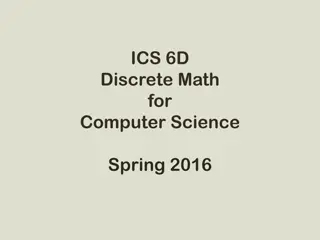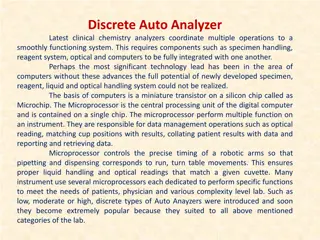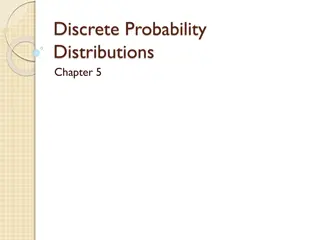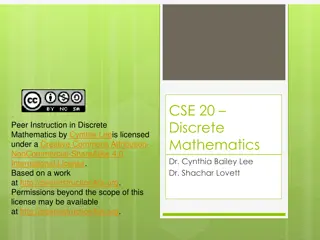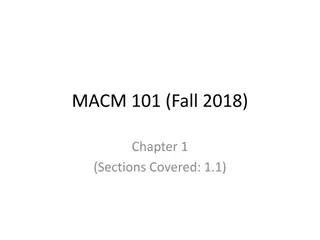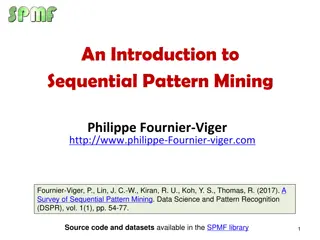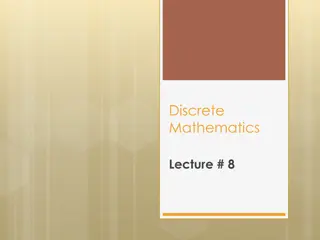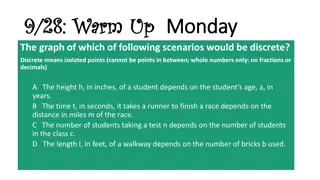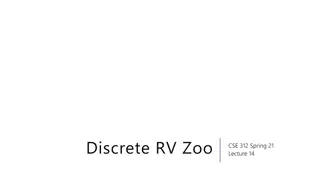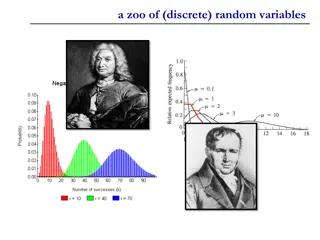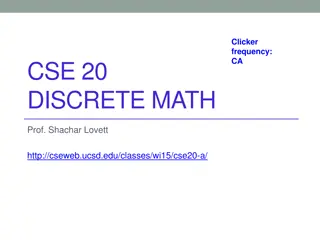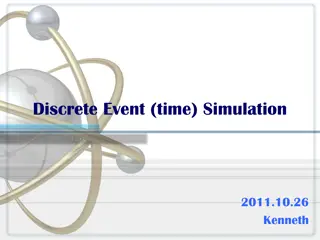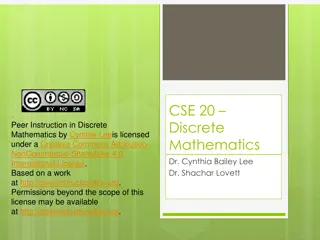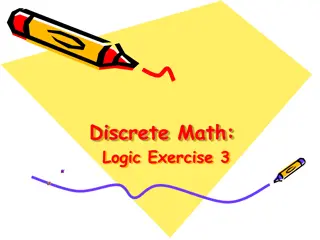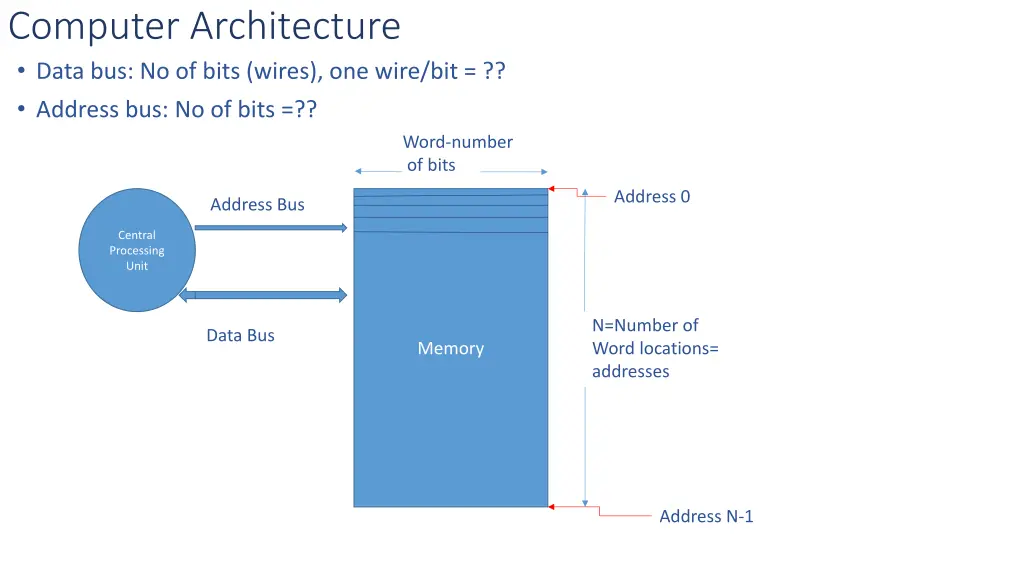
Understanding Computer Architecture and Permutations in Data Systems
Explore the intricacies of computer architecture, data bus configurations, and permutations in this informative guide. Learn about the number of bits in data and address buses, word lengths, and the significance of permutations in generating distinct words. Understand binomial coefficients and the concept of permutations with unlimited repetitions through detailed explanations and visual aids.
Download Presentation

Please find below an Image/Link to download the presentation.
The content on the website is provided AS IS for your information and personal use only. It may not be sold, licensed, or shared on other websites without obtaining consent from the author. If you encounter any issues during the download, it is possible that the publisher has removed the file from their server.
You are allowed to download the files provided on this website for personal or commercial use, subject to the condition that they are used lawfully. All files are the property of their respective owners.
The content on the website is provided AS IS for your information and personal use only. It may not be sold, licensed, or shared on other websites without obtaining consent from the author.
E N D
Presentation Transcript
Computer Architecture Data bus: No of bits (wires), one wire/bit = ?? Address bus: No of bits =?? Word-number of bits Address 0 Address Bus Central Processing Unit N=Number of Word locations= addresses Data Bus Memory Address N-1
Computer Architecture Data bus: No of bits (wires)= number of bits in the CPU/memory word Address bus bits = log2N =log2N iff integer, else the next greater integer than log2N (the ceiling of log2N) Word-number of bits Address 0 Address Bus Central Processing Unit N=Number of Word locations= addresses Data Bus Memory Address N-1
Permutations () with unlimited repetitions , arrangements, permutations, putting objects in a certain order. How many distinct words (identification tags) are with n Greek letters? 24n Proof: Let the No of words with n-1 letters be T(n-1). For each word with n-1 letters we can create 24 new words by adding another letter in front. Then T(n)=24*T(n-1) T(n-1)=24*T(n-2) .. T(2)=24*T(1) T(1)=24 Multiply the left and the right parts, T(n)=24n For binary (the letters are bits {0, 1}) the number of words T(n)=2n =N and n=log2N Consequently: if we need N identifications (tags, addresses) we construct word-length log2N (at least log2N )
Introduction to binomial coefficients ( ) We call the term n! n factorial ( n). It denotes the number of distinct permutations ( ) that can be produced by n distinct elements of a set. We will use the notation for this number as P(n). To form a line consisting of n positions with n distinct objects we use any of the n elements in the first place. Since we have removed one element (object) from the set they remain n-1 to choose for the second position. Since we have removed 2 elements from the set there are only n-2 available for the third place, etc. Therefore, the total number of permutations P(n) with n elements is n!=n*(n-1)*(n- 2) .*2*1.
Permutations () Another similar proof: Assume the permutations of n-1 objects We call the number of possible permutations as T(n-1) Assume an arbitrary permutation of n-1 objects. In this permutation if we insert another object, the nth, then for each permutation of n-1 objects we will produce n new permutations Example: 3 objects, a b c withT(3) and we insert d. Forthe arbitrary permutation a c b we will produce 4 new permutations: d a c b, a d c b, a c d b, a c b d T(4)=4*T(3)
Permutations () Therefore: T(n)=n*T(n-1) T(n-1)=(n-1)*T(n-2) T(n-2)=(n-2)*T(n-3) . T(2)=2*T(1) T(1)=1 Multiply left and right parts: T(n)=n*(n-1)*(n-2)* *2*1=n!
Permutations with r r elements out of n n Following the same reasoning if we are to choose r elements from a set with n elements and form lines with r elements, then the number of the distinct lines (permutations denoted as P(n,r)) will be n*(n- 1)*(n-2) .(n-r +1), which is obviously equal to n!/(n-r)! = P(n,r).
Permutations with repetitions P(n;q Permutations with repetitions P(n;q1 1,q ,q2 2, , , , q qt t): Example ): Example How many different routes from A to B can use a data-packet? (use moves: u, r) r B u C A How many through C ??
Permutations with repetitions P(n;q1,q2,,qt) What is the number of distinct words with a,a,a,b,c,d,d,e (using all the letters)? If we could use a1, a2, a3(3 distinct a s instead of 3 the same) and 2 distinct d s (d1, d2) then there would be 8! words. The 3 a s if they were distinct they would produce 3! permutations Since we cannot distinguish the a s, we 8!/3! permutations and for the d s 2! permutations Therefore the number of words is 8!/(3!*2!) Accordingly, for n objects and using q1 repetitions of the first, q2of the second, qt of the tth, P(n;q1,q2, ,qt)=n!/(q1! * q2! * ..*qt!)
Permutations with repetitions P(n;q Permutations with repetitions P(n;q1 1,q ,q2 2, , , , q qt t): Example ): Example How many different routes from A to B can use a data-packet? (use moves: u, r) r B u C A There are 10 r s and 3 u s to be used. Therefore, 13!/(10!*3!) Equivalent: No of words with 13 letters, 10 r s and 3 u s to be used. Question: how many routes from A to B, through C?
We would like to give user-id to subsets of the class for the network. The set of all the subsets is the power set ( ) How many bits do we need to describe the subsets? In a set of N elements: how many subsets are there? In a set of N elements: how many subsets of each kind (1-element, 2- element subsets, etc.) are there?
Combinations () If we would like to choose r objects from a set of nwithout any particular order (we do not care about the permutation) We know that P(n,r)= n!/(n r)! are all the possible permutations of n elements chosen from a set of n elements. We do not care about the permutations (their order in the subset), so divide the P(n,r) by r! ? ?= ? No of choices is C(n,r) = P(n,r)/r! = n!/(n r)!r!= ? ?
Subsets (Combinations) In sets we do not care about the order of the elements and hence, we use combinations In a set with n elements a subset may have relements, 0 r n. No of subsets with r elements is C(n,r) = n!/(n r)!r!= No of subsets in total: ? 0+? ? ? 1+? 2+ +? ? ? ? 1+? ? ? = 2n ?+ + ? ?+ + ? 2+
Subsets of a set with n n elements For a set S of n elements (distinct) Construct a word of n bits such that: Use a 1 in the position x iff the corresponding element (x) exists in the subset else use a 0 Example: For the set {a, b, c, d, e} we represent the subset {a, d} as 10010, the {b, c, e} as 01101, the {a, b, c, d} as 11110, etc. There is a one-to-one correspondence between the subsets and the binary words, hence the ( ) power set |S| has 2n elements-subsets (need n bits to describe all the subsets).
Computer Architecture Data bus: How do we use the computer data word (k bits)? Word-number of bits Address 0 Address Bus Central Processing Unit N=Number of Word locations= addresses Data Bus Memory Address N-1
Data Representation with k k- -bit Non negative integers with k bits, 2k words mapped on: 0 to 2k-1 bit words 2k-2 2k-1 0 1 2 3 . Integers with k bits, words mapped on: -(2k-1-1) to 2k-1-1 2k-1-1 0 -(2k-1-1) Mapping of non negative integers: 0000 0B 0D, 11111 11B 2k-1D
Non negative reals with k bits, 2k words, k-1 bits integer and 1 bit fractional mapped on: 0 to 2k-1-1+(1/2) 2k-1-1+(1/2) 1/2 3/2 2k-1-22k-1-1 0 1 2 3 .
Non negative reals with k bits, 2k words, k-2 bits integer and 2 bit fractional mapped on: 0 to 2k-2-1+(3/4) 2k-2-1+(2/4) 5/4 1/4 2k-2-22k-2-1 0 1 2 3 . 2k-2-1+(3/4) Accuracy (resolution): the closest distance to 0: here is 1/4
Number Systems A number representation at any base (b) system (non negative real): am-1*bm-1+am-2*bm-2+ +a2*b2+a1*b1+a0*b0+a-1*b-1+a-2*b-2+ .+a-k*b-k Integer part fractional part ExampleDecimal: 1078.25D 1*103+0*102+7*101+8*100+2*10-1+5*10-2 Example Binary: 10000110110.01B (=1078.25D) 1*210+0*29+0*28+0*27+0*26+1*25+1*24+0*23+1*22+1*21+0*20+0*2-1+1*2-2 Most Significant Bit (msb) Least Significant Bit (lsb)
Backup slides for Number Systems: multiplication/division by a base power (repetition from elementary school) Decimal: 12300D*100D=1230000D (shift left, symbol <<) 12300D/10D=1230D (shift right, >>) Binary: 1100100B*100B=110010000B (shift left, <<) 1100100B/10B=110010B (shift right, >>)
Backup slides for Number Systems: Addition/Subtraction example with positive numbers (repetition from elementary school) 137 Decimal: a) 7*100+6*100 =1*101+3*100 + 876 b) 3*101+7*101+1*101=1*102+1*101 1013 c) 1*102+8*102+1*102=1*103+0*102 1001 Binary: a) 1*20+1*20=1*21+0*20 +1011 b) 0*21+1*21+1*21=1*22 +0*21 10100 c) 0*22+0*22+1*22 =1*22 (zero carry) d) 1*23+1*23 =1*24 +0*23
Number Systems b=2: 1s Complement For a binary number A with b=2 A=am-1*bm-1+am-2*bm-2+ +a2*b2+a1*b1+a0*b0+a-1*b-1+a-2*b-2+ .+a-k*b-k A=am-1*2m-1+am-2*2m-2+ +a2*22+a1*21+a0*20+a-1*2-1+a-2*2-2+ .+2-k*b-k In 1 s C the negative of A is =2m-A-2-k Example with a 5-bit integer number (m=5) the A= 01011. 2m 100000 -A - 01011 = 10101 -2-k -00001 = 10100 The has all the bits of A inverted. With n bits we produce 2n-1 numbers, because it has 0=00000=11111 (double 0) 1 s Complement ( 1)
Number Systems b=2: 2 2s Complement For a binary number A with b=2 A=am-1*2m-1+am-2*2m-2+ +a2*22+a1*21+a0*20+a-1*2-1+a-2*2-2+ .+2-k*b-k In 2 s C the negative of A is =2m-A Example with a 5-bit integer number (m=5) the A= 01011. 2m 100000 -A - 01011 = 10101 The has all the bits of A inverted and we add a 1 at the least significant bit (lsb) OR: the 2 s C of A is the 1 s C with the addition of the 1 at the lsb. s Complement ( 2)
Number Systems b=2: 1s In all systems (1 s C and 2 s C) the positive numbers have the same representation Example with 4-bit integers Positive Negatives 1 s C Negatives 2 s C (advantage: one representation for 0) 1 s and 2 s Complements and 2 s Complements 8 1000 7 0111 1000 1001 6 0110 1001 1010 5 0101 1010 1011 4 0100 1011 1100 3 0011 1100 1101 2 0010 1101 1110 1 0001 1110 1111 0 0000 1111
Number Systems b=2: 1s and 2s Complements 1 s and 2 s Complements Using k bits to represent integers in 1 s and 2 s Complements 1 s Complement 1 s Complement 0 -(2k-1-1) 2k-1-1 - 2 s Complement -2k-1
Graph (, ) G=(V, E), V ( , node, vertex ) (label) (V N). E ( , edge), (VxV) ={ (i.j) | i,j V} V, (i.j) i j graph (directed). E (?,?) (j,i) graph (undirected), |E| V(V-1)/2. 2 1 2 1 4 6 3 5 3 4 6 5 ) Directed Graph ) Undirected Graph
O - (adjacency matrix) V V , (i,j) 1 (i,j) 0 . Path i k edges i k. Adjacency Matrix Adjacency Matrix Nodes 1 0 1 1 1 0 0 2 1 0 0 1 0 0 3 1 0 0 1 1 0 4 1 1 1 0 0 0 5 1 0 1 0 0 0 6 0 0 0 0 0 0 Nodes 1 0 1 1 0 0 0 2 1 0 1 0 1 0 3 1 1 0 0 0 0 4 0 0 0 0 0 1 5 0 1 0 0 0 0 6 0 0 0 1 0 0 1 2 3 4 5 6 1 2 3 4 5 6 Adjacency Matrix Directed Graph (example A) Adjacency Matrix Undirected Graph (example B)
Cycle (): path ( i k) i (k,i). Acyclic Graph ( ): Tree ( ), directed acyclic undirected cycles: {1,3,4}, {1,2,4}, {1,2,4,3}. (1,3) (1,4) edges ( ) . 1 2 4 3 6 5
Tree with a root : (ancestor) root. j : edge (root,j) (child) root. k (j,k) child j ( j parent k) (descendant) root, (k,m) m child k, . children leaf ( ). root parent root. Height ( ): ( ) root (leaf). root: root 2, leaves 1, 6 5. height 3= 2 (root) 5 1 4 children 2 (root) T 3 6 children 4, 5 child 3. 1 2 4 3 6 5
Binary Tree ( ): root 2 children, parent root. vertex 2 children, vertex children leaf. vertices k edges root level ( ), 2?vertices: root 20. root children 21 vertices, ( ) vertices 2?( k) binary tree (h=height) 2 leaves. , h vertices ( ) ?=0 ?= 2?=2 +1-1.
Complete Binary Tree root Pointer to parent Height (h = 3)
Full Binary Tree root Pointer to parent Height (h = 3) Number of leaves = 2 Number of nodes =2 +1 1
: Multiplexer 8-to-1: Tree of MUX with h=2, 2-to-1 MUXs 2h+1-1 AND gates 2(2h+1-1) OR gates 2h+1-1 Output OR AND AND ?2 (control line) ?0 ?0 ?1 Multiplexer (MUX) 2-to-1 ?1 ?0 ?0 ?3 ?5 ?1 ?2 ?4 ?6 ?7 2h inputs

